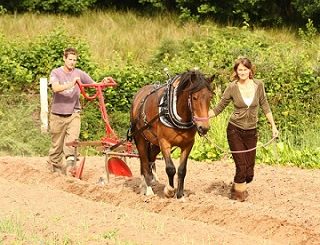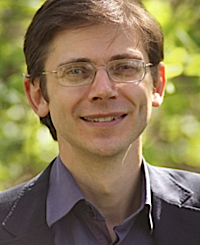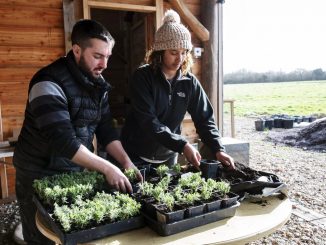This contribution by Miles King was not commissioned as part of the livestock debate, but it is very apt as it taps into the core issues in the debate. It originally appeared on his blog.
As Arthur Fallowfield, the farmer character in the legendary Radio 4 comedy series ’Beyond our Ken and Round the Horne, would have said, “The arnswer loies in the soil”.

I read, with interest and increasing disbelief, an article by George Monbiot in the Guardian. George, who I hold in very high regard, claimed that eating a kilo of Beef or Lamb, especially if it’s from animals that have lived in the uplands of Britain, had the same carbon footprint as an individual flying to New York. George also couldn’t quite believe what he was reading and contacted the author for more information. You can find the calculations at the bottom of George’s piece on his own blog (not the Guardian version.)
I had a look at the paper the figures were based on – as I don’t have access to scientific references for free I wasn’t able to see where George had got his figures from, but the paper was published in the Journal of Agricultural Science. The paper compares the carbon footprint of cattle and sheep from 2 upland farms in the Cambrian mountains of Wales – and was received for peer review in February 2009. And yes, using these figures, you can get to the astonishingly high carbon footprints George mentions in his article.
But the story does not end there.
18 months later the same author, Professor Gareth Edwards-Jones, published a much larger more comprehensive study of 20 upland farms in the Cambrian Mountains. This was published as a CCW policy research report in September 2010. This gives quite a different – in some cases completely polar opposite, picture to the one George has painted.
On three of the 20 farms where the study took place, the production of cattle and sheep caused a net sequestration of Carbon. Yes, that’s right. Producing lamb and beef can actually lead to the storage of Carbon. How could this be?
The answer really does lie in the soil. Soils, mostly under grassland, are the UK’s second largest carbon store, after peatlands. One third of the UK’s Carbon is stored in grassland soils, many of them in upland areas. The capacity for grasslands to store carbon depends on a number of things, including how they are managed. Grassland soils can also release the very potent greenhouse gas Nitrous Oxide, again depending on how they are managed – or example whether artificial Nitrogen fertiliser is applied. So how upland grasslands are managed has a huge impact on the carbon footprint of the animals, and therefore the meat, which is produced there.
As the Edward-Jones research found, this carbon footprint can range from 4 to 17 kgCO2e/ha for a kilo of lamb (liveweight) and 4 to 23 kgCO2e/ha for beef (table 3), before the Carbon sequestration happening in the grassland soils of the farm is even taken into account. Edwards-Jones did not calculate the per kilo carbon footprint after sequestration. He also used a conservative estimate of the capacity of grasslands to absorb carbon. Had he used a slightly less conservative estimate of carbon sequestration another 3 farms out of 20 may have been shown to be net Carbon sinks (table 9).
Time and again in the CCW paper, the authors point out how little research has been done into Carbon storage and sequestration in grasslands. Which is extraordinary when you consider that this is far and away the most important factor in determining the carbon footprint of meat from livestock. What is known is that wildlife-rich grasslands are known to contain high levels of carbon in their soils – up to 438 tonnes C per ha (opens pdf download) – that’s equivalent to over 1700 tones of CO2e – far higher than agriculturally improved ones. And converting arable or improved grasslands back to wildlife-rich ones causes them to rapidly absorb carbon, one study found at over 3 tonnes per ha per annum (opens pdf download) while continuing to provide grazing/fodder for livestock.
It seems strange that this very important piece of work was not published in a scientific paper. Sadly the reason was that Professor Edwards-Jones died of cancer in August 2011.
The problem with treating upland farming as one “thing” is that you end up with simplistic pictures of their environmental impacts, costs and benefits. Even among the 20 farms within the Cambrian Mountains research study there is huge variation. That variation will be reflected in other parts of upland Britain. But one thing does appear to be consistent – that uplands that support semi-natural habitats – wildlife-rich grasslands, upland heathland, peatland, mires, scrub and so on – are net carbon sinks, hold water back to prevent downstream flooding, produce high quality food, and provide homes for some of our most threatened wildlife.
They are very different from other uplands (which form the majority) – the uplands overgrazed in the past and to a lesser extent today, supporting very degraded upland acid grassland, or grasslands that have been agriculturally improved.
While there may be good arguments for rewilding some uplands, the carbon footprint of meat produced there, amongst other factors, would indicate that some uplands are better for rewilding; and others need to be cherished for what they are now.
Miles King is a conservationist based in the UK. This article originally appeared on his blog. To view him debating with George Monbiot on rewilding see the video below
https://vimeo.com/81154332





Awesome!